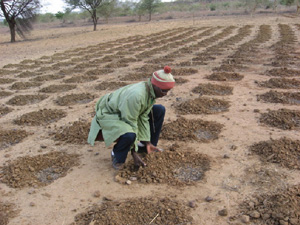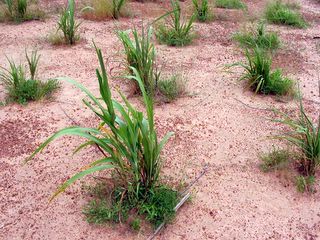Difference between revisions of "How to Start Culture in Zai Holes"
(→Categories) |
|||
| (4 intermediate revisions by the same user not shown) | |||
| Line 14: | Line 14: | ||
==Description== | ==Description== | ||
| − | Mali and Burkina Faso's Farmers apply the | + | [[File:WA-pit-300.jpg|500px]][[File:ZaiGrowth.jpg|500px]]<br> |
| + | Mali and Burkina Faso's Farmers apply the Zai technique to recover crusted land in semi-arid regions. <br> | ||
| − | + | Zai is a hole, a planting pit with a diameter of 20-40 cm and a depth of 10-20 cm - the dimensions vary according to the type of soil. | |
| − | Pits are dug during the dry season from November until May and the number of | + | Pits are dug during the dry season from November until May and the number of Zai pits per hectare varies from 12,000 to 25,000.(The number of zai per hectare and their dimensions determine how much water they harvest. The bigger the number and the smaller their size, the less water they each harvest.)The excavated earth is ridged around the demi-circle to improve the water retention capacity of the pit. |
After digging the pits, composted organic matter is added at an average, recommended rate of 0.6 kg/pit and, after the first rainfall, the matter is covered with a thin layer of soil and the seeds placed in the middle of the pit. | After digging the pits, composted organic matter is added at an average, recommended rate of 0.6 kg/pit and, after the first rainfall, the matter is covered with a thin layer of soil and the seeds placed in the middle of the pit. | ||
| − | + | Zai fulfils three functions: soil and water conservation and erosion control for encrusted soils. | |
| − | The advantages of | + | The advantages of Zai are that it : |
*captures rain and surface/ run-off water; | *captures rain and surface/ run-off water; | ||
| Line 31: | Line 32: | ||
*The manure applied to the pits contains seeds of trees or bushes. This helps the regeneration of the vegetation on fields treated with pits. | *The manure applied to the pits contains seeds of trees or bushes. This helps the regeneration of the vegetation on fields treated with pits. | ||
| − | The application of the | + | The application of the Zai technique can reportedly increase production by up to 500% if properly executed. |
==Difficulties== | ==Difficulties== | ||
| Line 65: | Line 66: | ||
=='''Categories'''== | =='''Categories'''== | ||
[[Category:Stub]] | [[Category:Stub]] | ||
| − | [[Category:Agriculture]] [[Category:Community]] [[Category:Composting]] [[Category:Fertilizer]] [[Category:Fruits]] [[Category:Ideas]] [[Category:Resource Management]] [[Category:Soil]] [[Category:Run-Off]] [[Category:Tree]] [[Category:Irrigation]] [[Category:Biodiversity]] | + | [[Category:Agriculture]] [[Category:Community]] [[Category:Composting]] [[Category:Fertilizer]] [[Category:Fruits]] [[Category:Ideas]] [[Category:Resource Management]] [[Category:Soil]] [[Category:Run-Off]] [[Category:Tree]] [[Category:Irrigation]] [[Category:Biodiversity]] [[Category:Water harvesting]] |
[[Category:Easy to Medium]] | [[Category:Easy to Medium]] | ||
| − | [[Category:Global Technology]] [[Category:Arid Climate]] [[Category:Monsoon Climate]] [[Category:Montaneous Environment]] [[Category:Rural Environment]] | + | [[Category:Global Technology]] [[Category:Arid Climate]] [[Category:Monsoon Climate]] [[Category:Rainy season]] [[Category:Montaneous Environment]] [[Category:Rural Environment]] |
[[Category:Clay]] [[Category:Charcoal]] [[Category:Compost]] [[Category:Cow dung]] [[Category:Manure]] [[Category:Seeds]] [[Category:Seedlings]] [[Category:Straw]] [[Category:One Person and more]] | [[Category:Clay]] [[Category:Charcoal]] [[Category:Compost]] [[Category:Cow dung]] [[Category:Manure]] [[Category:Seeds]] [[Category:Seedlings]] [[Category:Straw]] [[Category:One Person and more]] | ||
[[Category:Household]] [[Category:Village]][[Category:Neighbourhood]] | [[Category:Household]] [[Category:Village]][[Category:Neighbourhood]] | ||
Latest revision as of 14:15, 7 June 2010
Contents
Short Description
- Problem: Crusted land in arid regions, soil fertility, soil conservation, water conservation
- Idea: Planting crop in small holes enriched with compost
- Difficulty: Medium
- Price Range:
- Material Needeed: Digging material, Compost
- Geographic Area: Arid areas
- Competencies:
- How Many people?
- How Long does it take? Approx. 300 up to 450 hours per hectare digging the zai, 150 hours per hectare filling up with manure.
- Other Names: Planting pits, tassa
Description


Mali and Burkina Faso's Farmers apply the Zai technique to recover crusted land in semi-arid regions.
Zai is a hole, a planting pit with a diameter of 20-40 cm and a depth of 10-20 cm - the dimensions vary according to the type of soil. Pits are dug during the dry season from November until May and the number of Zai pits per hectare varies from 12,000 to 25,000.(The number of zai per hectare and their dimensions determine how much water they harvest. The bigger the number and the smaller their size, the less water they each harvest.)The excavated earth is ridged around the demi-circle to improve the water retention capacity of the pit.
After digging the pits, composted organic matter is added at an average, recommended rate of 0.6 kg/pit and, after the first rainfall, the matter is covered with a thin layer of soil and the seeds placed in the middle of the pit.
Zai fulfils three functions: soil and water conservation and erosion control for encrusted soils. The advantages of Zai are that it :
- captures rain and surface/ run-off water;
- protects seeds and organic matter against being washed away;
- concentrates nutrient and water availability at the beginning of the rainy season;
- increases yields; and
- Reactivates biological activities in the soil and eventually leads to an improvement in soil structure.
- The manure applied to the pits contains seeds of trees or bushes. This helps the regeneration of the vegetation on fields treated with pits.
The application of the Zai technique can reportedly increase production by up to 500% if properly executed.
Difficulties
- High labour to dig the zai holes ( between 300 and 450 hours/hectare)
- High maintenance labour (in soils with a high clay or gravel portion, pits require less maintenance than pits dug in sandier soils.)
- No mechanization possible.
- The pits should be dug during the dry season.
- Size and position are important.
- Composted organic material should be used, not raw organic material.
Success Story
Plans, Illustrations, Posters
Contacts
Links
http://www.ifpri.org/divs/eptd/dp/eptdp114.htm
http://www.worldbank.org/afr/ik/iknt80.htm
Bibliography
Related articles
- How to Use the Porous Clay Pots and Pipes System
- How to Start Composting
- How to Fight Soil Erosion by planting Vetiver Grass
Categories
- Stub
- Agriculture
- Community
- Composting
- Fertilizer
- Fruits
- Ideas
- Resource Management
- Soil
- Run-Off
- Tree
- Irrigation
- Biodiversity
- Water harvesting
- Easy to Medium
- Global Technology
- Arid Climate
- Monsoon Climate
- Rainy season
- Montaneous Environment
- Rural Environment
- Clay
- Charcoal
- Compost
- Cow dung
- Manure
- Seeds
- Seedlings
- Straw
- One Person and more
- Household
- Village
- Neighbourhood
- Application
- Howtopedia requested drawings
- Howtopedia requested images
- Requested translation to Spanish